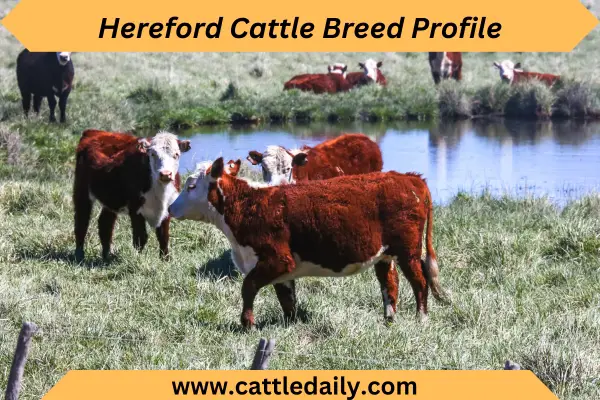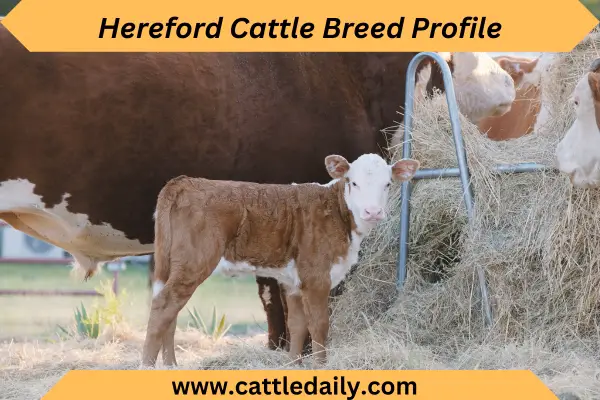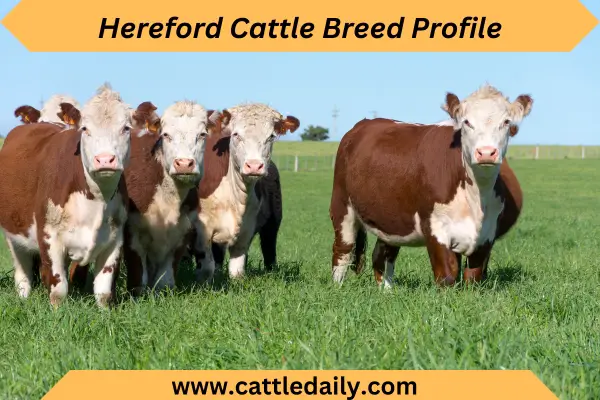Hereford Cattle Breed Profile
With their signature red bodies and distinctive white faces, Hereford cattle are an iconic beef cattle breed. Originally from England, Herefords gained popularity in the American West during the 19th century expansion of the cattle industry.
Prized for their hardiness, docility and high-quality beef, Herefords remain a prominent cattle breed today. In this article, we will provide an overview of Hereford cattle including their history, characteristics, uses and proper care.
Whether you’re a cattle producer looking to add Herefords to your herd or simply interested in learning more about this remarkable breed, read on to discover what makes Herefords such a noteworthy bovine.
A Brief History of Hereford Cattle
The Hereford cattle breed originated from Herefordshire, England in the 1700s. The breed was developed by farmers through selectively breeding local cattle to improve traits like hardiness, fertility, milking ability and beef production.
Some key events in Hereford history:
- In 1776, Benjamin Tomkins is credited with starting the improvement of Herefords through selective breeding.
- In 1817, Hereford cattle were first imported to the United States by Henry Clay.
- The American Hereford Association was founded in 1881 to maintain breed purity and promote Herefords.
- Herefords became very popular in the late 1800s as the beef industry expanded in the American West.
Today, Hereford cattle are found all across North America and in over 50 countries worldwide. They remain one of the most common purebred cattle breeds.
Why are Hereford cattle important?
Hereford cattle have played an integral role in the beef industry and food supply over the past two centuries. Here are some of the key reasons why Hereford cattle remain an important breed:
- Hardiness – Herefords are able to thrive under diverse environmental conditions from temperate pastures to extreme cold or heat. Their adaptability and fertility allowed cattle production to expand westward in North America.
- Maternal traits – Hereford mothers exhibit excellent maternal instincts, milking ability and calving ease. This allows them to be productive breeders requiring minimal assistance at calving.
- Marbling and tenderness – Herefords produce beef with superior marbling that enhances juiciness and flavor. Their high percentage of intramuscular fat improves the eating experience.
- Grazing efficiency – Herefords transform grass into lean beef efficiently. Their foraging genetics help producers maximize pasture utilization and reduce reliance on harvested forages.
- Docility – The placid temperament of Herefords makes them easier and safer to handle. Less stress during management benefits both cattle and handlers.
- Hybrid vigor – Crossbreeding Hereford genetics with other breeds imparts vitality and complementarity. Hereford-Angus crosses exhibit optimal production traits.
- Heritage significance – Herefords hold cultural value as one of the oldest English cattle breeds. They contributed greatly to 19th century expansion of the North American cattle industry.
Hereford cattle offer an optimal balance of adaptability, efficiency, docility, maternal ability and beef quality – traits that have maintained their popularity across cattle producers large and small.

Hereford Cattle Characteristics
Here are some of the defining physical and behavioral characteristics of Hereford cattle:
1. Coat Color
The most recognizable feature of Hereford cattle is their distinctive red body color coupled with a white face, underline, feet and tail. This color pattern is caused by the dominant Whiteface gene, which suppresses pigment in these areas of the body.
The red coat color becomes darker along the topline. Hereford calves are typically born with white-red faces that soon fill in with more redness.
2. Horns
Herefords are naturally horned cattle, with their horn shape curving inward and slightly forward. The horns emerge at the top of the poll region behind the ears. Hereford horns are medium length based on the breed standard.
Through selective breeding, polled (hornless) strains of Hereford cattle were developed beginning in the early 1900s. Polled genetics can simplify the dehorning process but horned Herefords remain popular.
3. Size
The Hereford is considered a medium to large-sized breed when mature. Hereford bulls reach an average weight between 1,800-2,500 pounds. Mature Hereford cows commonly weigh between 1,100-1,500 pounds.
Herefords possess a thick, muscular frame with a broad back and hindquarters. Their heart girth is deep and wide while their legs are short in relation to body length.
4. Appearance
In addition to their trademark red and white coloring, Herefords have an elegant, refined appearance. Their facial profile exhibits a broad forehead and width between the eyes and nostrils.
The face is short and complimented by a crest-like neck. Herefords have a powerful chest floor that blends smoothly into the underline. Their hide is loose and flexible.
5. Temperament
A significant attribute of Hereford cattle is their docile temperament. They are known for being mild-mannered, easy to handle and having a pleasurable disposition.
Hereford mothers exhibit strong maternal instincts and become very protective of their newborn calves. The placid nature allows Herefords to thrive in extensive grazing operations.
6. Climate Adaptability
A hallmark of Hereford cattle is their ability to adapt and flourish under varied environmental conditions. Their short, thick red coat offers cold tolerance to withstand frigid winters.
During summer heat, Herefords utilize shade and exhibit heat tolerance. However, adequate water and ventilation must be provided during extreme high temperatures.
7. Foraging Ability
Herefords are excellent grazers that transform pasture grasses into lean beef efficiently. Their short coat allows them to continue grazing during the winter. Herefords are able to travel long distances seeking fresh pasture.
Their lower nutritional requirements reduce supplemental feeding needs. Herefords exhibit parasite resistance.

Uses of Hereford Cattle
Here are the main uses of Hereford cattle in beef production today:
1. Beef Production
Hereford cattle are prized as an ideal beef breed. They produce high-quality carcasses with ample marbling and external fat coverage to ensure tenderness, juiciness and flavor.
Hereford beef grades well due to sufficient intramuscular fat. Their meat yields lean yet flavorful cuts. Herefords achieve superior dress-out percentages. They are optimal for producing fancied cuts like ribeyes or T-bones.
2. Crossbreeding
Hereford bulls are commonly mated with cows of other breeds to take advantage of hybrid vigor in crossbred offspring. Hereford-Angus crosses exhibit complementarity, combining the superior marbling of Angus with the milk production of Herefords.
Hereford bulls also impart calving ease and climate adaptability. Popular crosses are Red Angus Balancers (Hereford x Angus) and Black Baldies (Hereford x Black Angus).
3. Show Cattle
The Hereford’s attractive red and white coloring coupled with a docile disposition make them a popular show cattle breed, especially for youth.
Young exhibitors appreciate Herefords for their gentle nature when handled frequently and ease of training. Herefords are shown in specific breed classes as well as open shows for judging placement.
4. Polled Genetics
Hereford cattle carry dominant polled genetics, originally derived from a mutation. By selectively breeding polled Herefords, the horns can be removed.
Breeding polled Hereford bulls to horned cows results in polled offspring, eliminating the need for dehorning. Polled genetics appeal when avoiding disbudding pain or complications.
5. Grazing & Conservation
Herefords match the vast grazing lands of the American West. Their foraging capabilities and feed efficiency allow Herefords to finish on grass. Herefords can thrive on sparse vegetation, doing more with less.
Their environmental adaptability contributes to conservation grazing and sustainability. Herefords fit well with holistic grazing plans.
Hereford Cattle Care & Management
Here are some key considerations for raising healthy and productive Hereford cattle:
1. Nutrition
Herefords have lower nutritional requirements than other breeds. Provide good-quality roughage along with balanced rations. Ensure growing Herefords receive adequate protein, energy, minerals and vitamins.
They readily finish on forage-based diets but grain supplementation may be warranted. Avoid over-conditioning.
2. Facilities
Herefords do best in well-drained, open pens and pastures. Their coats don’t shed heat as well as other beef breeds, so provide shade on hot days. Their shorter coats also mean they require shelter during the coldest winter weather. Ensure good ventilation and limit crowding.
3. Reproduction
Hereford heifers can be bred by 15 months of age or when they reach 65% of their mature weight. Breed bulls by 18-20 months of age. Limit heifer’s first calf to 8% of her body weight.
Calving ease is excellent. Time calving when pasture nutrients are highest, like early spring.
4. Health
Herefords are generally healthy but susceptible to eye cancer, foot rot and pinkeye. Establish an animal health program with routine procedures like deworming, vaccination and lice control. Screen breeding stock for genetic defects through blood testing or DNA markers.
5. Transportation
Herefords travel well in trailers but are prone to respiratory stress. Avoid overcrowding trailers and transport during extreme heat. Provide proper ventilation. Bed trailers well and avoid abrupt directional changes while driving. Monitor closely for signs of shipping fever after transport.
Conclusion:
Hereford cattle have earned their place as one of the most recognized and respected beef breeds over the past 200+ years. Their ability to transform grass into delicious, well-marbled beef with efficiency and minimal maintenance costs drive demand among cattle producers worldwide.
Yet Herefords offer more than just tasty steaks and roasts. Their gentle nature, maternal instincts, climate adaptability and striking red and white coloring gives Herefords appeal both in the pasture and show ring.
With such a robust mix of favorable traits, Herefords are sure to continue grazing their way into the hearts and stomachs of cattle enthusiasts for generations to come. Learn here more about cattle breeds types and guides.


